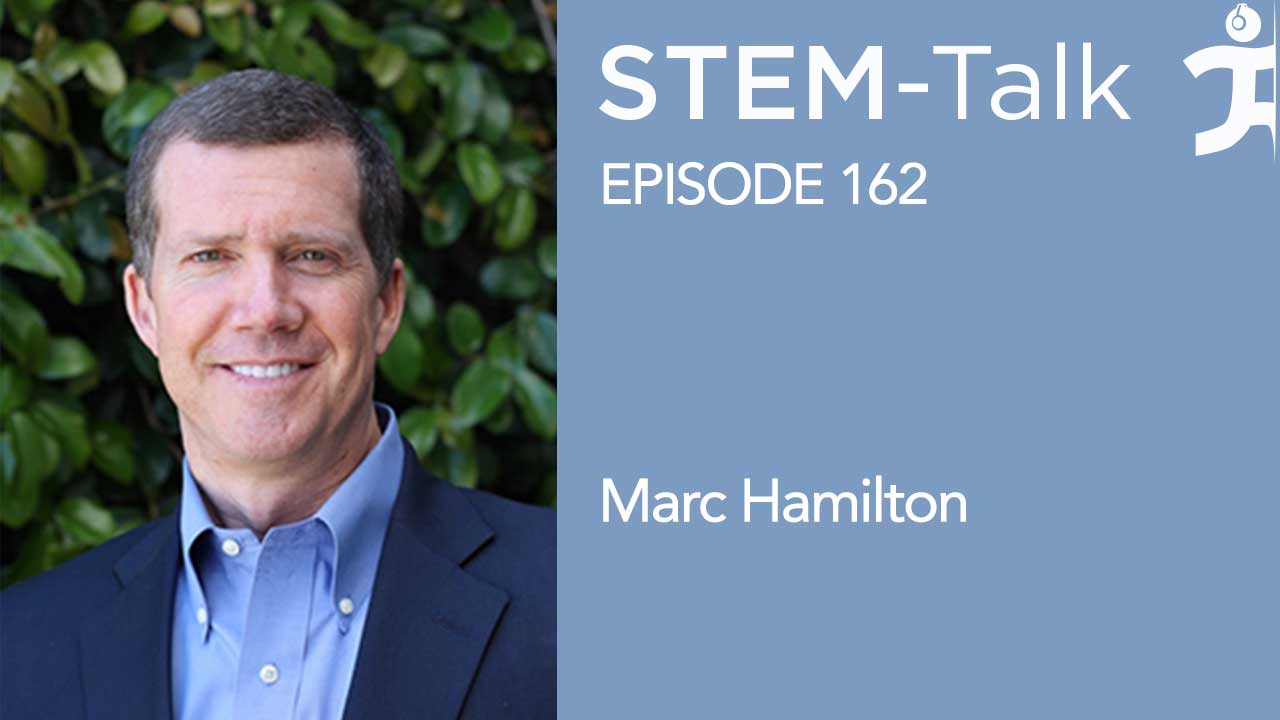STEM-Talk
Episode 162: Marc Hamilton discusses the soleus push-up and the health hazard of excessive sitting
// Jan 10, 2024

Today we have Dr. Marc Hamilton, an international expert in muscle physiology. He has published pioneering work on the soleus push-up, a potent physiological method which Marc discovered having the ability to elevate metabolism for hours, even while sitting.
As a professor of Health and Human Performance at the University of Houston, Marc’s research focuses on solving problems of metabolism and biochemistry. His lab currently has a number of ongoing investigations, including studies on the biochemical mechanisms that may optimize fat metabolism to fuel muscle when fasting between meals. This research includes a look at maximizing glucose metabolism while also reducing related plasma hyperinsulinemia due to chronic inflammation and carbohydrate ingestion.
Another recent area of research focus has been to improve metabolic health for preventing diabetes and pre-diabetes. This includes the goal of improving glucose tolerance. Research has shown that glucose intolerance has been a particularly troubling metabolic problem and has proven to be more difficult to treat than most people realize.
Marc is also well known for a string of papers beginning in early 2000’s that found excessive sitting should be viewed as a serious health hazard. This research illuminated how metabolic and biochemical processes are significantly impacted by certain types of prolonged muscular activity and inactivity.
In today’s interview, we particularly talk to Marc about his paper in iScience that reported that the soleus push-up’s ability to sustain elevated oxidative metabolism to improve the regulation of blood glucose is more effective than many popular methods currently touted as a solution.
Show notes:
[00:02:48] Marc begins the interview talking about his childhood and growing up outside of Houston. [00:03:49] Ken asks if Marc’s later affinity for the real-world scientific problems that he works on today was originally inspired, in part, by his childhood history of hunting and studying animal behavior and anatomy. [00:05:20] Marcas asks Marc what other hobbies he had as a child. [00:06:35] Marcas mentions that Marc didn’t go to college with the intention of becoming a scientist and asks Marc what he had in mind when he started his undergraduate studies at the University of Texas. [00:09:08] Marcas asks Marc if there was anything in particular in his zoology undergrad that sparked an interest in pursuing a master’s degree in exercise physiology. [00:10:15] Marcas asks Marc to talk about what he enjoyed the most about graduate school, particularly with his Ph.D. at the University of South Carolina. [00:16:05] Ken asks if Marc had a great deal of independence with his PhD. [00:17:27] Ken mentions that Marc went to the University of Texas School of Medicine in Houston for his postdoc research, which focused on physiology, cell biology, and pharmacology. Ken asks Marc what that time was like. [00:19:45] Ken asks Marc to talk about some fundamentals of muscle metabolism that listeners should keep in mind before diving deeper into his current research. [00:24:58] Marcas shifts to talk about Marc’s 2004 paper “Exercise Physiology vs Inactivity Physiology,” which focused on the enzyme lipoprotein lipase (LPL) and how periods of inactivity impact its regulation. [00:32:05] Ken mentions that Marc published a string of papers after his previously mentioned 2004 paper, elaborating on the same theme. Ken brings up his 2008 paper, titled “Too Little Exercise and Too Much Sitting,” in particular. Ken asks Marc to talk about his conclusion in that paper, that excessive sitting should be viewed as a serious health hazard. Ken also asks Marc if there is any efficacy to standing desks and balance boards that one sees in many workplaces now. [00:36:48] Marcas wonders if over the course of Marc’s research if he has seen any differences in the effects of inactivity across the sexes and asks Marc if the effects are roughly equivalent for men and women. [00:39:15] Marcas asks Marc what his opinion is on the movement to have benchmarks and reminders built into most smartwatches, considering that these goals aren’t very personalized. [00:42:27] Marcas shifts to talk about Marc’s 2014 paper “Sedentary Behavior is a Mediator for Type 2 Diabetes,” which looked at the use of moderate to vigorous physical activity, as typically recommended to mediate type-2 diabetes, but found that this did not fully counter the negative effects of too much sitting. Marcas asks Marc to explain why the metabolism in a slow-twitch oxidative muscle is so key in this respect for understanding the healthy response to load or moderate activity. [00:49:11] Ken shifts to discuss Marc’s 2022 article, titled “A Potent Physiological Method to Magnify and Sustain Soleus Oxidative Metabolism Improves Glucose and Lipid Regulation,” in which Marc introduces the idea of a soleus push-up. Ken asks Marc to give an overview of the soleus muscle and what proper activation of it looks like for achieving the potent benefits described in the paper. [00:55:32] Marcas asks about the design of the study, both with respect to the characteristics of the participants, as well as the research protocol. [00:59:43] Marcas asks how many contractions per minute can be expected when doing the soleus push-up correctly. [01:01:06] Ken asks Marc to briefly describe the primary findings of the paper. [01:05:38] Ken asks if there were any findings from that study that Marc really didn’t expect and hadn’t hypothesized. [01:07:10] Marcas explains that even though, on average, the soleus muscle is about 80 to 90 percent type 1 muscle fiber, there are differences in the ratio of composition across individuals. Given this, Marcas asks whether or not Marc has observed any individual differences between the participants’ responses from the muscle biopsies. [01:08:23] Since higher intensity exercise has lower energy economy and thus a higher metabolic boost both during exercise and during recovery, Marcas asks if Marc considered it to be an alternative to the sitting soleus push-up. [01:10:13] Marcas reiterated the importance of not viewing the soleus push-up as a replacement for other forms of exercise. [01:15:04] Ken asks Marc to explain how one performs a soleus push-up properly. [01:19:36] Ken mentions that the soleus push-up could be useful for people who often embark on long airline flights. [01:25:19] Ken follows up the discussion of Marc’s study on the soleus push-up by asking about his more recent study which also generated a lot of interest. [01:36:12] Marcas closes the interview asking Marc about an upcoming bow- hunting trip.Links:
Hamilton lab’s YouTube channel
Hamilton lab’s website about the soleus push-up
Free copy of one original scientific article in the journal iScience (Cell Press).






